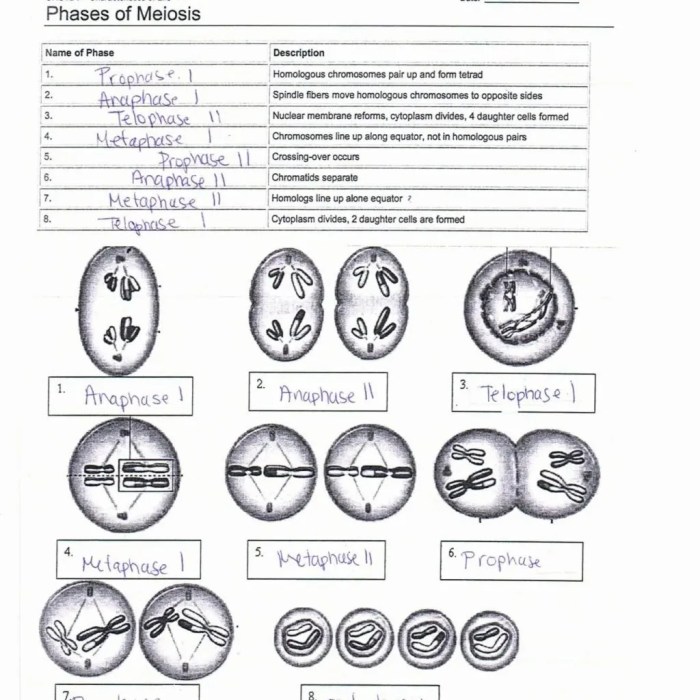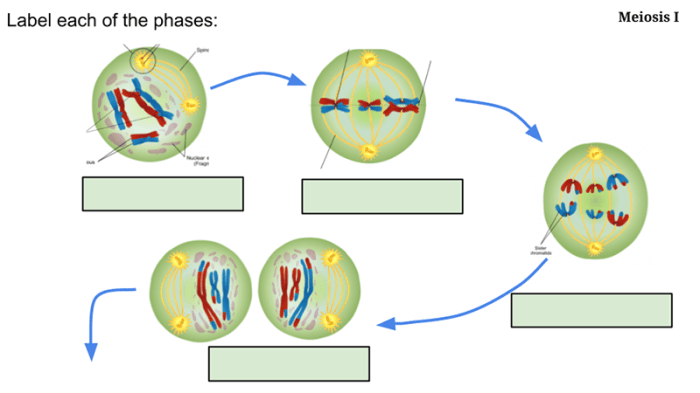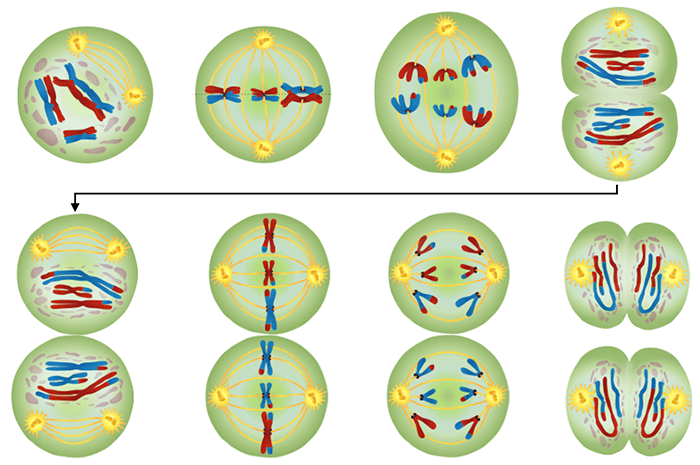Modeling meiosis activity answer key provides an in-depth understanding of the complex process of meiosis, its significance in genetic inheritance, and its educational value. This comprehensive guide explores the materials, procedures, data analysis, and educational benefits of using a modeling activity to teach meiosis.
The activity involves using pipe cleaners, beads, or other suitable items to represent chromosomes and alleles, allowing students to visualize the stages of meiosis, including prophase I, metaphase I, anaphase I, telophase I, prophase II, metaphase II, anaphase II, and telophase II.
It simulates crossing over and independent assortment, providing insights into genetic diversity and inheritance patterns.
Introduction to Modeling Meiosis Activity: Modeling Meiosis Activity Answer Key

Meiosis is a fundamental process in sexual reproduction, responsible for the creation of gametes (eggs and sperm) with half the number of chromosomes as the parent cells. Modeling meiosis activity provides a hands-on and interactive way to visualize and understand this complex process.
Through this activity, students can simulate the key stages of meiosis, including chromosome pairing, crossing over, independent assortment, and the production of haploid gametes. This approach enhances comprehension and facilitates the exploration of genetic diversity and inheritance patterns.
Materials Required for Modeling Meiosis Activity
- Pipe cleaners or yarn in different colors (to represent chromosomes)
- Beads or markers (to represent alleles)
- Scissors
- Tape or glue
- Whiteboard or large paper
- Markers or crayons
The use of different colors or types of materials helps distinguish between homologous chromosomes and their respective alleles.
Procedure for Modeling Meiosis Activity
Prophase I:
- Create pairs of homologous chromosomes (pipe cleaners) and attach beads to represent alleles.
- Allow students to observe chromosome pairing and crossing over (exchange of genetic material between homologous chromosomes).
Metaphase I:
- Line up homologous chromosome pairs along the “equator” (whiteboard or paper).
- Randomly orient each pair of chromosomes (independent assortment).
Anaphase I:
- Separate homologous chromosomes and move them to opposite poles.
Telophase I:
- Decondensed chromosomes and form two daughter cells with half the number of chromosomes as the parent cell.
Prophase II, Metaphase II, Anaphase II, Telophase II:
- Repeat the same steps for the second round of meiosis.
- Result in four haploid gametes with unique combinations of alleles.
Data Collection and Analysis
Students can record the allele combinations of the gametes produced and analyze the data to determine the expected outcomes based on the laws of inheritance.
Data analysis can reveal:
- Genetic diversity generated by independent assortment and crossing over
- Probability of inheriting specific alleles
- Patterns of dominant and recessive traits
Educational Benefits of Modeling Meiosis Activity, Modeling meiosis activity answer key
Modeling meiosis activity offers several educational benefits:
- Enhanced Understanding:Visualizing the process through hands-on manipulation deepens understanding of meiosis.
- Concrete Representation:Physical models provide a tangible representation of abstract genetic concepts.
- Exploration of Genetic Diversity:Students can observe the generation of genetic diversity and its implications for inheritance.
- Inquiry-Based Learning:The activity encourages students to ask questions, make predictions, and test hypotheses.
- Collaboration:Working in groups fosters collaboration and scientific discussion.
FAQ Explained
What is the purpose of modeling meiosis activity?
To provide a visual and hands-on representation of the complex process of meiosis, enhancing understanding of its stages and implications for genetic inheritance.
What materials are required for modeling meiosis activity?
Pipe cleaners, beads, or other suitable items to represent chromosomes and alleles, as well as markers or labels to indicate different genetic traits.
How does the activity simulate crossing over and independent assortment?
By physically exchanging segments of pipe cleaners or beads during the modeling process, representing the exchange of genetic material between homologous chromosomes and the random distribution of alleles during meiosis.

